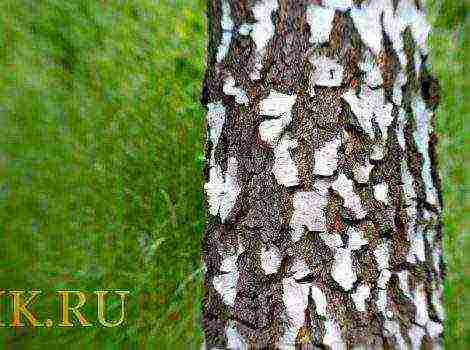Content
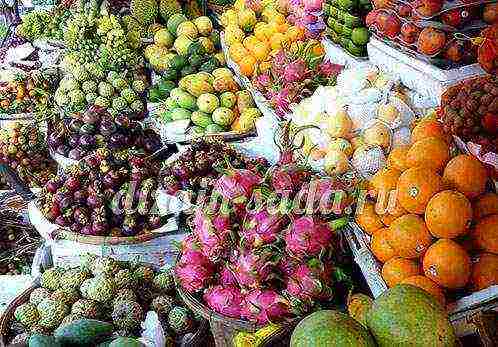
Many types of exotic fruits can be grown at home, it would be a desire, a little patience and Internet access.
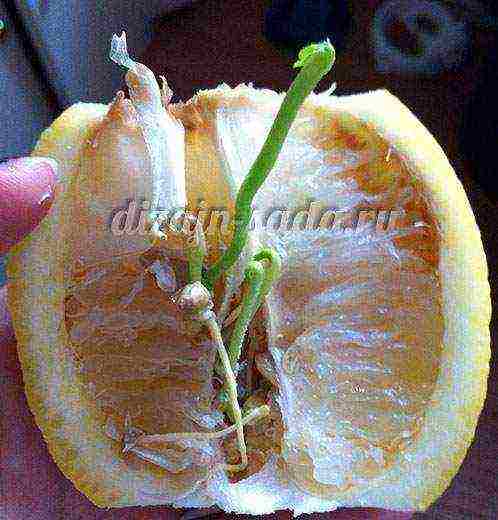
Citrus fruits: we grow lemon, tangerine, grapefruit at home
The most popular are citrus plants. Since these plants require a lot of heat, they grow well and bear fruit in a garden that is reliably protected from the cold. Lemon, orange, grapefruit - you can easily grow all this at home. Caring for such plants does not require special gardening skills.

How to grow an Avocado at home
An avocado sprouts from a seed taken from a fruit. The stone is placed with a blunt end in the soil, and the tip is left to protrude above the surface. Before the leaves appear, the plant needs an air temperature of about 18 degrees, and in the winter, avocados need to be kept at low temperatures.

Grow Pineapple at home
To grow pineapple, you need to cut off the top with a piece of pulp from its fruit and plant in wet sand. Pineapple needs to be watered frequently. True, grown in a winter garden, this fruit will not always be able to produce truly fragrant fruits.

Is it possible to grow Bananas at home
Growing bananas at home is a painstaking task, these plants require special care. Banana is propagated by offspring, and some species are propagated by seeds. The air temperature should be high - 24-28 degrees, and in winter not lower than 16. A banana needs abundant watering, as well as a regular supply of organic fertilizers. And this plant begins to bear fruit no earlier than the 3rd year.
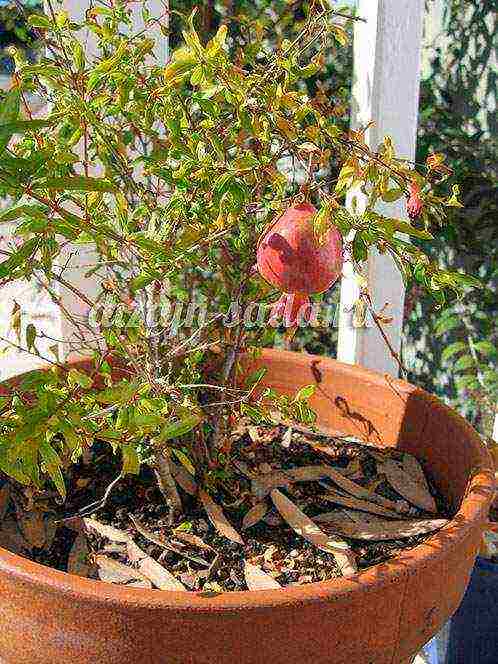
How to grow pomegranate at home
Another plant that can be grown in the winter garden is punica. Or, more simply, a room grenade. The tree can grow up to 1 meter tall and bloom every year. But it does not always give fruit, since in a winter garden it may experience a lack of heat. For the appearance of fruits, you should use the heating of the winter garden in the autumn period or sometimes transfer the plant to the room.
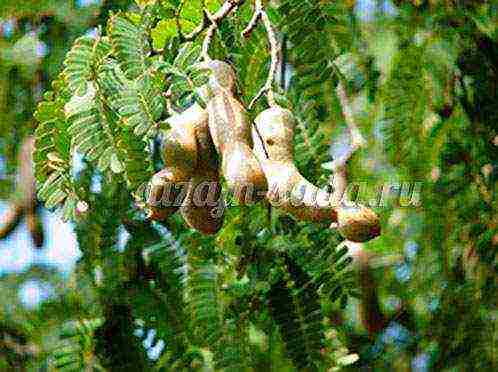
Growing dates from stone
A common plant among gardeners is the date. It successfully sprouts from dried fruit pits at temperatures above 20 degrees. In winter, the temperature of the date should drop to 12-14 degrees.

Coffee and laurel trees can be grown at home
If you are a budding gardener, then you can easily start by growing coffee and laurel trees. In a winter garden, these plants grow well and yield a harvest. It is important to take into account that in winter, the temperature of their content should not exceed 10 degrees.
If you have grown any exotic fruits and plants at home, please write to us about your success. Did your exotics bear fruit? Have you tried growing pomegranate, tangerine, lemon or grapefruit from the seed? Share your experience, because it will help other readers to try themselves in this interesting and exciting business.
source
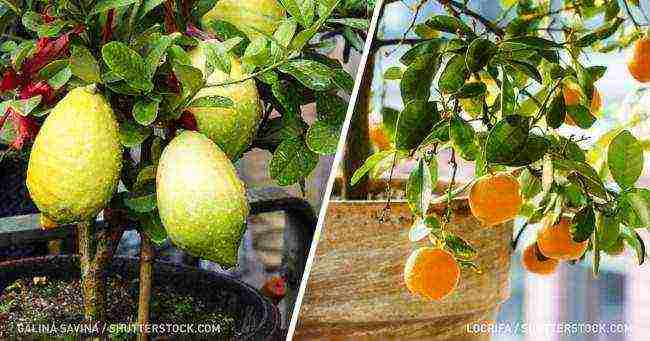
The time has come for planting, the migration of seedlings from the windowsill to the garden and painstaking worries about the future harvest. Fresh fruits without unnecessary additives delight much more purchased ones. And for those who do not have their own land, advises not to get upset, but to try to grow fruit directly from the seeds at home or even at work.
Of course, the fruit will have to wait, and in some cases more than one year. Growing fruit, however, is a good anti-stress and also a reason to get closer to colleagues.
Citrus
Citrus fruits like lemon, tangerine, orange, grapefruit, etc. have a rich aroma and can be experimented with almost all year round. The seeds for sowing must be fresh. Planting them is quite simple: we wash the seeds and plant them in a moist mixture of garden soil, peat and river sand or special soil for citrus fruits. It is best to immediately plant each bone in a separate pot or glass.
It is very important to provide plants with sufficient light, but protect them from the midday sun and dry air. In addition, citrus fruits must be kept at a temperature of 12-16 degrees in winter.
Date fruit
Even a dried date bone can grow a palm tree. It is better to soak it for several days before planting. Plant it in a mixture of peat and sand, and remember to moisten it with a spray bottle every 2 days. In about a month, the future palm tree should emerge. Like citrus fruits, dates require a lot of light and a cool winter.
Feijoa
The seeds of this exotic plant should be selected from the ripe and soft fruit. If the purchased feijoa is not yet ripe, you can put it in a warm place and wait a few days. The seeds should be washed from the pulp and dried. Without digging deep, we put the seeds in the ground with sand.
The plant can rise and germinate quite quickly. Therefore, do not forget to plant the sprouts, pinch the main root and transplant it together with the old soil into a larger pot.
Fig
To grow a non-fig tree, you need to do the same as with feijoa seeds: rinse, dry and put shallow in moist soil. Sprinkle a little sand on the soil and cover with foil. Find a warmer place for figs. The first shoots will appear in about 3 weeks, if you regularly moisten the ground and ventilate the room. In the warm season, keep the temperature at least 20 degrees, and in winter, no higher than 14 degrees.
Passion fruit
If you plant passionfruit seeds, most likely, not a fruitful tree will grow, but a liana, which will delight you with its luxurious flowering. However, who knows, maybe it is you who will be able to achieve a juicy fruit at home. Passion fruit loves everything that tropical plants like: bright light, a lot of air, warmth and high humidity.
Avocado
There are two ways to grow this storehouse of vitamins from the bone. In the first case, we remove the shell from the bone, set the wide side to a depth of 2-3 cm so that the tip protrudes above the surface. The second method is called open: we leave the shell and at the level of the middle of the bone we drill 3 small holes at an angle of 120 degrees. 3 matches are inserted into them, which will be supports along the edges of a glass of water. The water level must be maintained exactly below the bone. Once there are enough roots, the seed can be planted in a pot.
Before the leaves appear, the plant needs an air temperature of about 18 degrees, and in winter the avocado loves coolness.
A pineapple
Pineapple has no seeds, but you don't need them to grow it. It is enough to cut off the top of it with 2 cm of pulp and plant it in wet sand, for example, river sand. Pineapple loves water and will need to be watered frequently. In a winter garden, this fruit does not always yield the same fragrant fruits as its southern comrades. But it is quite possible to grow it at home.
Garnet
A safe option is the dwarf pomegranate, which bears fruit quite well even in mid-latitudes. He will calmly endure aridity, but not a lack of heat. A dwarf pomegranate will delight with flowers and bear fruit almost all year round even with a growth of 40 cm. The average yield is 7-10 edible fruits up to 5 cm in diameter.
Preview photo credit Galina Savina, Locrifa
Lemon
Many novice gardeners are familiar with the very feeling when a fragile sprout suddenly emerged from a bone planted by your hand.
A fragile sprout makes its way into the light from the bone
Some have a feeling of miracle and involvement with Nature. Others turn on "God Mode". But in a confined space, and even in winter, both of them often pour out into uncontrolled botanical ecstasy, and the seeds of all the exotic fruits that were found in the area are sent to the ground in generous handfuls.
"If you plant this seed, you will grow a whole peach tree, all hung with juicy peaches."
Seed to Citrus
Mandarin, orange and a hybrid of their clementine, lemon and lime, grapefruit, pomelo (sheddock) and their hybrid sweet (oroblanco), mineola (a kind of tangelo - a hybrid of mandarin and grapefruit), kumquat (aka kinkan or fortunella), limequat (kumquat hybrid with lime), oranjequat (hybrid of kumquat with unshiu tangerine), calamondin (citrofortunella), etc. - representatives of the genus Citrus are beautiful, fragrant, multifaceted and available for experimentation almost all year round.
Representatives of the Citrus genus are beautiful, fragrant, multifaceted and available for experiments almost all year round. The seeds selected for sowing should be as fresh as possible: without additional moisture, their germination decreases every day.
General advice for planting are quite simple: rinse the seeds and plant them in a well-moistened mixture of garden soil, peat and river sand (or in a special soil for citrus fruits). As soon as 1-2 true leaves appear on the sprouts, they need to be planted. And it is better to immediately sow them in separate pots or cups.
Citrus seeds are interesting because you never know what will grow from them: theirseedlings, especially hybrids, usually do not retain varietal characteristics your parents. A wildflower will grow from a citrus seed, and you will probably have to wait 10 years for your own harvest from it. Therefore, if your goal is to collect lemons or oranges directly from the windowsill, it is better to find cuttings of the desired varieties and plant your seedlings. This can be done one and a half years after planting.
If your goal is to pick lemons or oranges straight from the windowsill, it's best to find cuttings of the right varieties and plant your seedlings.
From seeds of lemon, orange or grapefruit, excellent rootstocks grow - healthy, strong and initially adapted to home conditions. But kumquats, tangerines and various hybrids are more capricious and are not suitable for rootstocks: their root system is not so powerful.
Despite the generic "community", citrus fruits when grown from seeds behave differently. Mandarins, for example, are "slow" in growth, but they are not so demanding on the composition of the soil. The first seedlings from mandarin seeds can appear in 3-4 weeks. A kumquat planted at the same time will "think" at least up to 2 months. Each citrus has its own flowering and fruiting times. But they have enough common enemies: dry air, spider mites, scale insects, aphids, etc.
The most popular "supplier" of material for citrus experiments has been and remains lemon. You can find out about your personal experience of growing lemons from seeds in this article.
Lemon on the windowsill
And the general rules for caring for a home citrus garden are set out in the article Tame a bright fruit.
Pitted persimmon
Diospyros, or persimmon, is a "divine" fruit from the Ebony family, which is rarely seen on windowsills. Meanwhile, it is also quite possible to grow it from a bone. This is done like this:
Persimmon
- We plant the washed and slightly dried persimmon seeds in moistened soil, cover with foil, glass or a piece of plastic bottle and put in a warm place;
- We periodically remove the "greenhouse", ventilate and moisten the soil;
- As soon as sprouts appear, the shelter can be removed.
Wait for shoots not long: just a couple of weeks. But if during this time you did not see them, then they are unlikely to appear at all.However, persimmon germination is not bad. For example, out of the three seeds I planted on 11/23/14, two successfully sprouted. Here is one of the sprouts today:
Persimmon seedling 2 months after planting. Photo: herbivicus And here is a funny time-lapse of how this happens:
I also had two plants at first quietly coexisted in one pot. But then the leaves began to turn yellow, so the seedlings had to be urgently planted. At first, transshipment will be required more than once or twice, because persimmon has a powerful root system that develops quickly and requires free space. And moisture. Persimmons need regular watering and spraying. Therefore, we carefully monitor the soil, avoiding overdrying or overflow.
Experienced persimmons are advised to feed the plant with fertilizers (mineral and organic alternately) twice a month. As soon as the "tree" grows up to 20-30 cm, you can begin to shape it by pinching. In summer, it is better to take the persimmon out into the street or on the balcony, gradually accustoming it to the sun. But she needs to provide a cool winter (+ 5 ... + 10 ° C): for example, in the basement. If a tree lives at home from November to March, sooner or later it will die.
Indoors, persimmon grows only up to one and a half meters. If a tree is grafted (with a cuttings in a cleft in winter or with a bud at the end of summer), then it can bear fruit in 3-4 years. Otherwise, the harvest will have to wait as long (and it is not a fact that it will be).
Read more about the types and varieties of persimmon, as well as how to care for it and where you can get hold of material for planting and grafting, read here.
Dried fruit date palm
I always loved dried dates, but last year these guys surprised me: I didn't know that something could grow out of them.
You can grow a palm tree from the seeds of a date
It turns out, how! Dates when dryingnot heat treated... This means that their seeds do not lose their germination. And from them you can try to grow a palm tree. Only the bones are best pre-soaked. Although this is not necessary if the product is fresh, i.e. came from his homeland to our counters quite recently. But, just in case, I was reinsured and soaked the date pits for about a week, changing the water every day. True, she did not scarify and did not suit other dances with a tambourine. I stuck them vertically into a mixture of peat and sand and moistened them with a spray bottle in a day or two as needed. After about a month, my future palms have sprung up:
Date shoots
And here's how they grew up in another month:
Date palms 2 months after planting
It's too early to think about the harvest) Although no one will forbid us to dream, at best, such a miracle in feathers will grow from a date "feather":
Date palm.
This is provided that she has enough light and space, and I have enough patience. And, alas, I have not yet come across evidence that she is able to bear fruit in indoor conditions.
Date palm care consists in regular watering (without overdrying the earthen coma, and in winter watering is minimized) and spraying, airing, providing sufficient light and conditions for a cool wintering. In addition, during the first "five-year" period, the plant needs to be transferred annually to a larger pot. But how great, probably, in the evening to sit under a palm tree to drink tea!
Mango-mango
Huge bones are hidden in the fruits of this large Indian guest. “Mango” is even translated from Sanskrit as “great fruit”. Its seeds are extracted from ripe fruits, open, take out the core and germinate in a light and loose substrate (soil is suitable for cacti or succulents). Expanded clay drainage is placed at the bottom of the pot - as, indeed, in all other cases.
Mango The middle of the already opened seed is planted immediately. The undisclosed one is carefully revealed (if it is ready for it) - as in this video:
If it is not possible to move the flaps apart without effort, the bone is preliminarily kept for a couple of weeks directly in water (the water is changed every other day) or wrapped in damp cotton wool / towel. At the same time, it is extremely important keep it dry... After the emergence of shoots, they will have to be regularly sprayed: mango is sensitive to air humidity, as well as to light and heat. It cannot stand the cold at all, and even at + 18 ° C it begins to feel uncomfortable. Well, if everything suits him, soon you will grow up something like that.
Having decided to grow mango from a stone, be prepared for the fact that you will have to wait 5 or even 10 years for flowering at best. , what can we say about the windowsill in foreign latitudes.
Feijoa
In the case of feijoa (which is also called akka and belongs to the Myrtle family, which translated into the language of flower growers means some difficulties with wintering), the situation is about the same as with citrus fruits: varietal characteristics during seed reproduction are almost not preserved, which means that seedlings will have to be vaccinated. If this does not stop you, keep in mind that the seeds for planting should be taken from a ripe and soft fruit (it will ripen perfectly in a warm place). Small seeds must be carefully washed from the pulp and dried. Sowing is done superficially, without deepening (you can mix seeds with sand).
Feijoa
If the seeds have enough light, warmth and moisture, they will germinate in about a month. In the first months, Akka seedlings develop rapidly, so they need
pick
and transshipment and then pinching to form a compact
crowns
.
Fig tree (fig)
Seeds of figs (figs, or ficus carica) for planting are "harvested" in the same way as from feijoa: they must be carefully washed, dried and sown superficially into moist, loose soil. Then lightly "sprinkle" with sand, cover with foil and find a warmer place for them. They sprout in about 3 weeks, all this time they need to be regularly moistened and ventilated.
Fig
Sometimes difficulties arise with fruiting, but some gardeners manage to get
fig
fruits from three to four year old seedlings.
Passion fruit (passionflower)
Passion fruit, aka passionflower, is actually a tropical vine from the Passionflower family.
Passion fruit, she is passionflower
The fruits of this evergreen beauty from South America are edible whole, including the crunchy seeds. However, if you plant them, there is a chance that you will have a vine, and someday you will admire its luxurious flowering without leaving your home.
Passion flower Just do not forget to provide it with bright light and fresh air, warmth, space, high humidity and "enhanced" nutrition.
Lychee
According to legend, one Chinese emperor ordered his gardeners to be executed for failing to grow this sugary miracle.
Lychee
Since then
lychee
considered one of the most troublesome candidates for seed growing at home? But this is true if only because the "Chinese plum" is one of those rare plants that needs
mycorrhiza
... Otherwise, this is a very cute creature with narrow pinkish leaves.
Coffee tree
In order to grow such a cute one from a grain, it is easier to immediately go to Africa, Asia or South America and pick up the fruits of the coffee tree there. Seeds ordered in an online store are unlikely to germinate: they very quickly lose their germination (I say this from my sad experience, it is quite possible that I am wrong, and you will be luckier). In loose, slightly acidic soil and greenhouse conditions with good lighting, a coffee bean will eventually turn into a wonderful tree.
Coffee tree
What else can be grown from seeds? A lot of things, there would be materials and a place for the experimentarium! For example, our colleagues successfully grow kiwi, medlar and even pepino from seeds. And soon you will find out what happens when you plant avocado and pomegranate seeds.
Growing seedlings is exciting, sometimes too much.
In general, growing seedlings is exciting.
But over time, you realize that this is a rewarding job - for patient, caring and responsible "testers". Eating a fruit, planting seeds and waiting for sprouts - this is so, a bouquet-candy period. But then the fun begins. After all, the fruits of labor will have to wait for years. And in the literal sense, you can not wait for the fruit (in the case of avocado and date palm, that's right). At the same time, care for the pet - watering, feeding, light and heat conditions - has not been canceled. The main thing is to remember that we are responsible for everyone who was put in a pot of soil and forced to sprout from the seeds. And if difficulties do not frighten you, - good seedlings and generous harvests!
Have you tried growing something from a seed? Let's share our experience!
Read also:
- How to grow pineapple, oranges, figs or watermelon at home?
- Children of the sun from southern countries: exotics in containers
- Passionflower is an amazing exotic
- Feijoa - is it realistic to grow a southern tree
- Calamondin is a sedentary fruit!
- I'll plant an avocado! What else is needed for happiness?
- And dates can grow in Siberia!

Try growing one of these exotic plants from seeds at home on your own. Moreover, it is not as difficult as it seems at first glance.
Buying delicious vegetables and fruits (including exotic ones) in the store, we get planting material for free. So why not use it rationally? After all, it is quite simple to grow a fruit-bearing tree or shrub from seeds.
1. Citrus fruits
With proper planting and care, citrus plants develop quite quickly, but fruiting does not come soon. Therefore, in order to enjoy homemade lemon or orange, you have to be patient: the first fruits will appear no earlier than in 5-7 years.
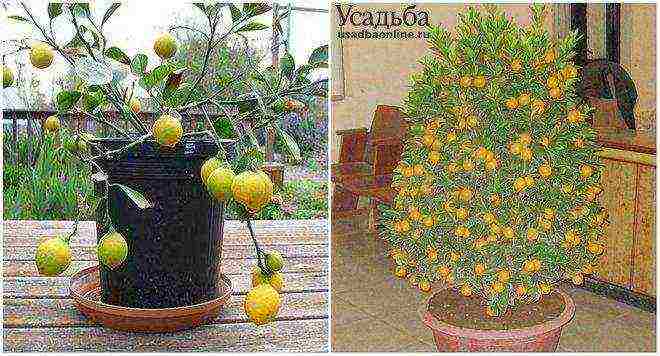
Lemon and tangerine
To grow citrus fruits from seeds, rinse the seeds with warm water, dry for 1-2 hours, and sow in a pot of soil that is intended for growing a specific type of citrus plant.
The pot in which you place the seed should be at least 2 liters, since it is not recommended to replant the plant for the first few years. Do not forget to put drainage on the bottom.
Immediately after sowing, it is necessary to make a greenhouse from a thin plastic bag. This will help maintain the required humidity level. When dry, the soil must be moistened in a timely manner.
For different types of citrus fruits, the seed germination time is not the same: from 3 to 8 weeks. Tangerines grow slower than others.
Citrus fruits grown from seeds at home reach no more than 90 cm in height.
2. Avocado
This is an unpretentious plant, so even a beginner can easily grow it. Peel the brown skin of a ripe avocado, plant it with the blunt end down so that the sharp end protrudes from the ground, and water regularly.
You can land in another way: lower the bone with the blunt end down into a container of water so that it is half immersed in the liquid. Secure the bone with a thread or a toothpick, place the container on the windowsill and add water as needed.
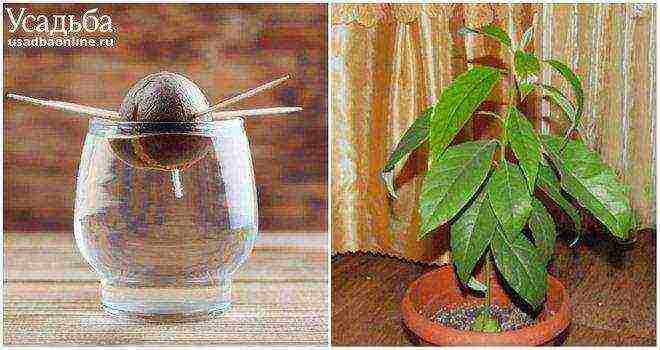
Avocado
The bone should hatch after 3-12 weeks. Germination time depends on many factors: proper watering, seed maturity, etc.
When the seed cracks and a sprout emerges from the crack, plant it in a small pot of any fertile soil, half buried. Water the plant in time - and after 3 months it will grow up to half a meter high.
3. Feijoa
Growing a feijoa from a stone at home is also not difficult. Separate the seeds of the ripe fruit from the pulp, rinse in a weak solution of potassium permanganate, dry and sow in a medium-sized pot with a mixture of leafy soil, peat and river sand in a ratio of 2: 2: 1 to a depth of no more than 0.5 cm. It is best to do this in February.

Feijoa blooms beautifully
Then moisten the soil with a spray bottle and place the pot on a well-lit windowsill. Water the crops in a timely manner - and in a month the seeds will germinate. The first fruits will appear after 5-6 years.
At home, it is recommended to grow self-pollinated feijoa varieties (for example, Crimean early or Nikitsky aromatic).
4. Passion fruit (passionflower)
This tropical vine loves to grow in a warm and ventilated place, but not in a draft, with good lighting and high humidity.
If you nevertheless decide to grow a passion fruit from a stone, find a spacious place for it in advance: the vine grows strongly, so a narrow window sill will not work for this exotic plant. You will also need support to support the shoots.
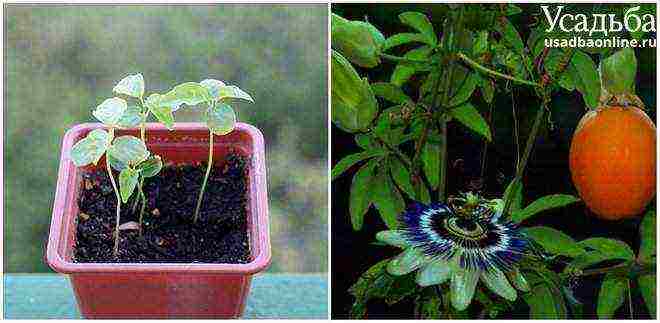
Passion fruit
Passion fruit seeds are easy to plant. The most suitable time for this is mid-spring.
Remove the seeds from ripe fruits, spread them on a clean towel and rub gently. When the juice bags open, rinse the seeds with water and dry in a dark place.
Sow the seeds into a container with a mixture of compost, topsoil, and river sand in equal proportions. Sowing is best done in small grooves spaced 5 cm from each other.
You do not need to deepen the seeds, just sprinkle them with a thin layer of soil and immediately moisten them with a spray bottle. With proper care, passion fruit will bloom 2-4 years after sowing.
5. Pomegranate
Pomegranate grown from the seed blooms for 3-4 years, but its fruits ripen at home for a very long time. Therefore, these plants are grown more out of interest than for the purpose of feasting on delicious pomegranates (as the fruits of this culture are called in botany).

Pomegranate and its seedlings
The most suitable time for sowing pomegranate is winter. Remove the seeds from a fully ripe bright red fruit and, without waiting for them to dry, plant them in fertile soil to a depth of 1-1.5 cm.
Water the crops in a timely manner. Shoots will appear in 1-2 months. Once they have matured, transplant them into separate pots.
Keep in mind that the pomegranate should be dormant throughout the winter, so move it to a cool place every year in late autumn.
6. Pepino
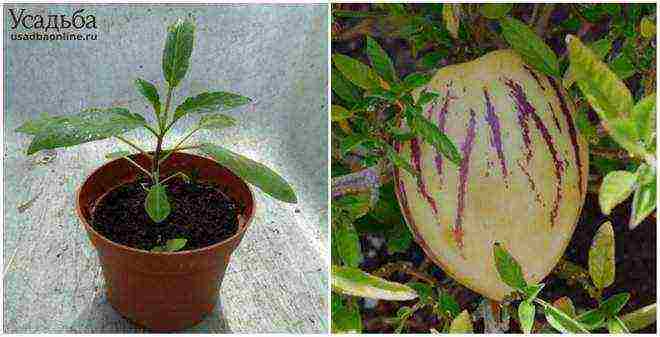
Pepino, or melon pear
This plant is often called the melon pear, because its fruit looks like a pear, and tastes like a melon. To grow pepino at home, remove the seeds from the fruit, put them in a shallow container, wrap them in damp toilet paper, cover with plastic wrap and place in a dark place with a temperature of about 25 ° C.
Moisten the seeds with a spray bottle every 2-3 days. When they hatch, move the container to a well-lit area. When the cotyledons appear, dive the seedlings and plant them in a pot with fertile soil. Please note that pepino is very demanding on light.
7. Date
A date palm grown from a seed at home develops quite quickly and after 5-7 years it can turn into a full-fledged tree. But, unfortunately, you should not expect fruits from such a plant: dates do not bear fruit at home.

Date fruit and date palm
Soak the freshly removed seeds in a glass of room temperature water for two days, then peel them of the pulp. Plant vertically in lightly damp palm soil and lightly dampen the soil occasionally. Shoots should appear after 2-3 weeks.
Do not forget that the date palm does not tolerate excess moisture, but it also does not like completely dry soil.The date does not like transplants and, if the roots are damaged, it quickly dies, so it is better to immediately sow seeds in a container of sufficient volume.
8. Kiwi
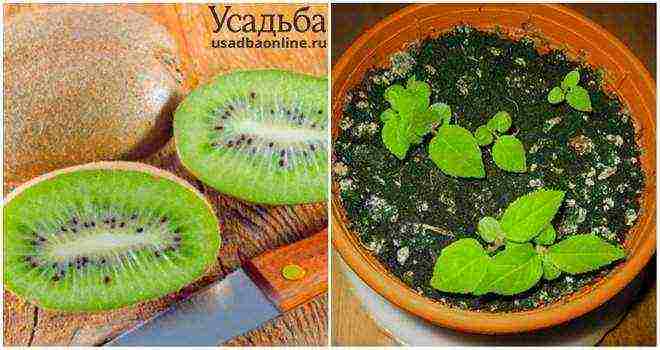
Kiwi seedlings
To grow kiwi from seeds at home, you need to choose a ripe fruit with an intact skin, extract the seeds from it and peel the pulp. At the same time, try not to damage the integrity of the small seeds.
Rinse the seeds thoroughly with water several times, dry on a napkin, and then place in a glass of water at room temperature. Place it in a warm place (for example, on a windowsill above the radiator).
After 7-10 days, when the seeds have opened, spread them out on damp gauze, place on a saucer and cover with plastic. When the seeds hatch (usually after 2-3 days), sow them in separate containers with a pre-moistened mixture of black soil, peat and sand.
Kiwi should grow in constantly moist soil, but it is important to avoid stagnant water. Therefore, drainage (expanded clay) should be placed on the bottom of the container and the seedlings should be sprayed with a spray bottle. It is better to choose a warm and sunny place for the plant: a windowsill located on the south side is suitable.
Try growing these exotic plants from seeds. They will decorate your home, dilute the usual flower garden with their unusual look. And they will also give the joy of the experiment, the results of which, perhaps, will be a real surprise for you!
